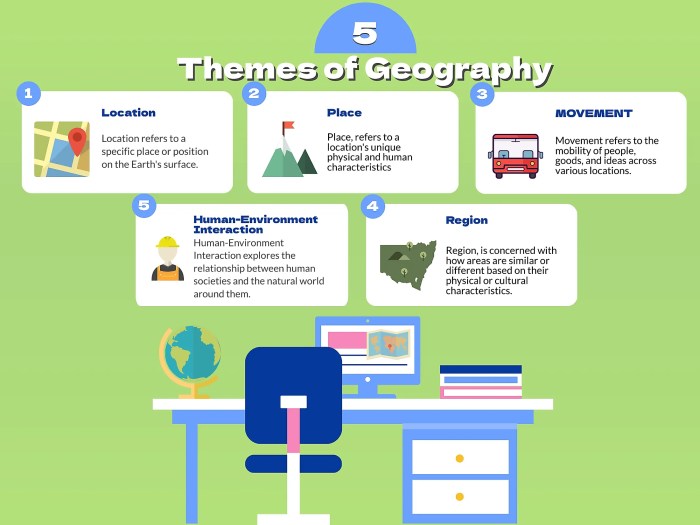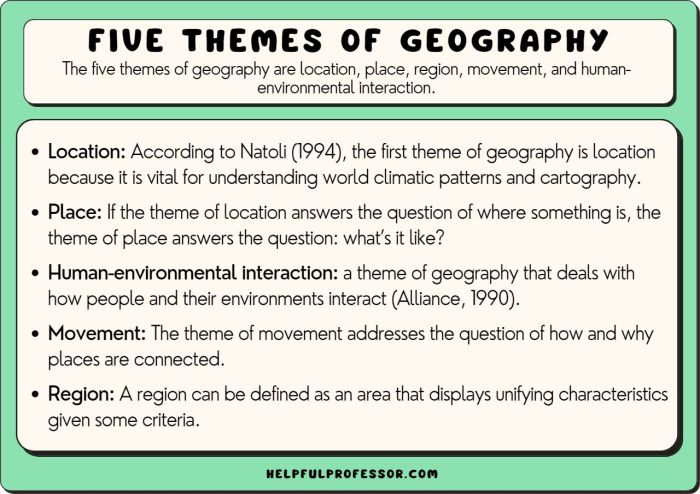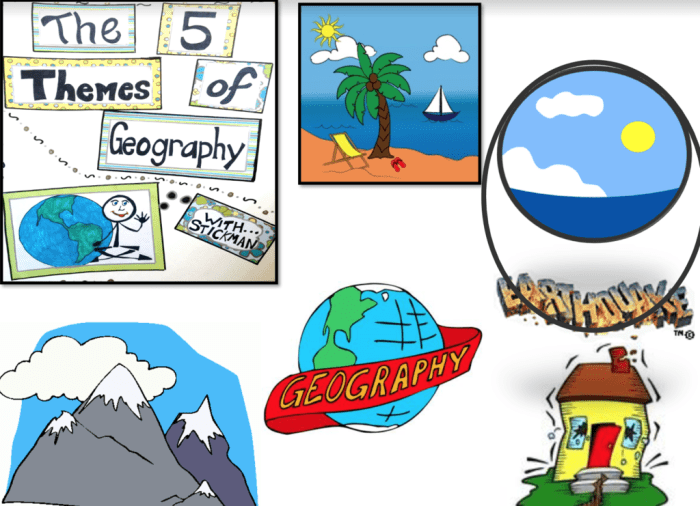Flocabulary five themes of geography – Flocabulary’s Five Themes of Geography provide a comprehensive framework for understanding the world around us. This engaging and accessible approach explores the interrelationships between location, place, human-environment interaction, movement, and region, empowering us to grasp the complexities of our planet.
Five Themes of Geography

Geography is the study of the Earth’s surface and its human and natural features. Geographers use five themes to organize their study of the Earth: location, place, human-environment interaction, movement, and region.
Location
Location refers to the position of a place on the Earth’s surface. There are two types of location: absolute and relative.
Absolute location is the exact position of a place on the Earth’s surface. It is usually given in terms of latitude and longitude.
Relative location is the position of a place in relation to other places. It is often described in terms of direction and distance.
Place, Flocabulary five themes of geography
Place refers to the physical and human characteristics of a location. The physical characteristics of a place include its climate, landforms, and water bodies. The human characteristics of a place include its population, culture, and economy.
Places can be described in a variety of ways. Geographers often use the following five elements to describe a place:
- Situation
- Site
- Land use
- Transportation
- Services
Human-Environment Interaction
Human-environment interaction refers to the ways in which humans interact with their environment. These interactions can be positive or negative.
Positive interactions include the ways in which humans use the environment to meet their needs, such as by farming, fishing, and mining.
Negative interactions include the ways in which humans damage the environment, such as by pollution, deforestation, and climate change.
Movement
Movement refers to the movement of people, goods, and ideas. Movement can be across short distances or long distances.
The movement of people is often driven by economic factors, such as the search for jobs or better living conditions.
The movement of goods is often driven by trade. The movement of ideas is often driven by communication and technology.
Region
Region refers to an area of the Earth’s surface that is defined by one or more common characteristics. Regions can be defined by physical characteristics, such as climate or landforms, or by human characteristics, such as culture or economy.
Regions can be large or small. The world can be divided into several major regions, such as the Americas, Europe, Asia, Africa, and Antarctica. Regions can also be divided into smaller subregions, such as the United States, Canada, and Mexico.
Common Queries: Flocabulary Five Themes Of Geography
What are the Five Themes of Geography?
Flocabulary’s Five Themes of Geography include location, place, human-environment interaction, movement, and region.
How do the Five Themes of Geography interconnect?
The Five Themes are interdependent and influence each other. For example, the location of a place affects its physical and human characteristics, while human activities can shape the environment and influence movement patterns.
Why are the Five Themes of Geography important?
Understanding the Five Themes provides a comprehensive perspective on the world, enabling us to analyze and interpret geographic phenomena, make informed decisions, and appreciate the diversity and interconnectedness of our planet.



